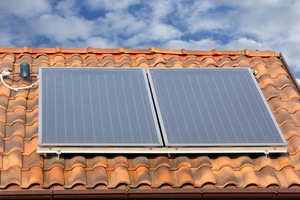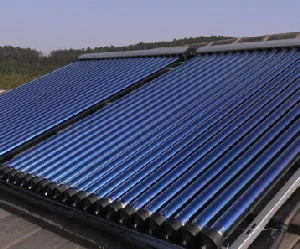
Solar Thermal Energy
Solar Thermal Energy Heats Water for the Home
![]() Today, Solar thermal energy has been a popular choice for heating domestic hot water (DHW) over many decades now and as we know, solar power is an effective weapon in saving energy as well as reducing the electricity bill.
Today, Solar thermal energy has been a popular choice for heating domestic hot water (DHW) over many decades now and as we know, solar power is an effective weapon in saving energy as well as reducing the electricity bill.
Generally, solar thermal energy uses solar hot water panels, or collectors, and especially evacuated tube technology to increase the efficiency level of a solar heating system by absorbing and storing more heat for a longer time.
These thermally efficient systems convert the sun’s solar radiation directly into usable heat. Solar thermal energy is certainly not a new idea its been around as an alternative energy resource for hundreds of years heating up our water or drying our clothes.
But domestic solar thermal technology has come a long way in the last 25 to 30 years as solar water heaters started to become more common place due to the fact these devices are useful, inexpensive and simple to install. Therefore in case you are searching for a different energy source to lower the ever increasing cost of electrical energy, you may want to think about a solar thermal water heating system.

A solar powered hot water heating system, also known as a solar thermal energy or solar heating system, is really a very simple system that utilises the heat from the sun’s rays to heat up water for the home and domestic use.
Compared with solar photovoltaics, the captured heat energy of the panel is not converted into electricity. Then a solar hot water heating system is nothing more than a large heater which is constructed to assist your present heating boiler by capturing the suns solar thermal energy.
Solar hot water collectors do not boil your water to high temperatures, but instead pre-heat the water using the sun, meaning that your existing oil, gas, and electrical heater are utilized much less whilst still delivering the same amount of warmth and comfort. The big advantage of using the suns solar thermal energy to heat your water, is that no matter were you live, you are able to still produce totally free hot water just using the power of the sun.
The immense heat generated by the sun is harnessed utilising either an evacuated tube collector, an integral collector storage (ICS) systems or even a simple solar flat plate collector (there are more designs but these three are the most common).
These solar collectors, so referred to simply because they “collect” the sun’s energy, are generally located on a roof of the house or fixed to a wall oriented in the direction of the midday sun. A solar collector harnesses the solar thermal energy of the sun and subsequently uses this thermal energy to heat the water within the collector.
Solar thermal collectors are generally made from glass fronted and fully insulated box having an absorber plate usually made from sheet aluminium or copper inside. Water is then pumped through a series of pipes in the collector and is heated.
The hot water returns to a tank for storage, basically similar to a standard home heating system. Generally, a solar thermal collector can produce enough hot water for the average family, or could be used on its own as part of a swimming pool heating system, or used for space heating.
Solar collectors are excellent for harnessing the suns solar thermal energy. Thermal collectors are usually classified into three different classes or types which include integral collector storage systems, flat plate collector, along with evacuated tube solar collector.
The preferred solar powered water heater uses evacuated tubes as they are more effective when compared to flat plate collectors. This is because of their design, which allows evacuated tubes to provide much greater efficiency’s and water temperatures while heating the water for long periods.
As their name suggests, solar vacuum tube collectors are composed of a number of clear, glass solar vacuum tubes positioned together side by side, with each one containing a copper absorber tube. They work like a thermal flask by heating a special heat conducting material inside a tube encased in a outer evacuated tube.
The suns light passes through the tubes glass body and heats up the copper absorber pipe inside, converting it to heat. This copper pipe has a heat transfer liquid, usually water, inside that absorbs the heat and transfers it by means of conduction to a storage tank via a heat exchanger.
An evacuated tubes effectiveness comes from the fact that along with there being a vacuum inside, giving it its name “evacuated tube”, these glass tubes are totally sealed therefore the copper pipe and the liquid inside it lose very little heat outside, even during a freezing cold day.
This process with modern solar technology is so efficient that over 80% efficiency is possible making it by far one of the best solutions for solar water heating as the heat energy goes into the tube but is not reflected back out.
As the thermal solar tubes are totally closed and sealed, the small amounts of yearly maintenance required, for example cleaning and inspection, is generally straightforward making it easy to remove any damaged glass tubes if required.
Solar powered hot water heating systems are an excellent investment and smart way to greatly reduce your carbon footprint along with reducing your bills with a basic installation.
Should you use natural gas or oil to heat your domestic hot water tank, possibly solar thermal energy is really a smart way to lower your bills. Whilst evacuated tube solar collectors tend to be more expensive compared to solar flat plate collectors, the enhanced performance, increased efficiency and reduced maintenance costs means a quicker payback period and higher return on investment.
One disadvantage of using a solar thermal system is that you may need some kind of backup heating system, especially throughout the rainy period or overcast days when the solar collector experiences reduced thermal energy from the sun, or for those days when teenagers are in the home and the hot water usage increases significantly.
Solar thermal energy is a free and easy way to heat water but there are numerous other ways in which to heat water making use of the energy from the sun. Hopefully the information given here will help in your investigation into the many benefits of using this amazing technology, because as with all types solar energy technology, it will lower your bills together with your carbon footprint, giving it many instant and long lasting advantages.
To gain a better understanding of how Evacuated Tube Collectors work and how you can use them to heat the water in your home, or to obtain more solar hot water facts about the various types of solar thermal heating systems available, or to explore the advantages and disadvantages of using solar thermal energy in the home, then why not Click Here today to get your copy of one of the top DIY solar thermal hot water books and plans from Amazon today.










I want flat plate solar collector that used collect 60 degree celsius for domestic solar water heating system with their parameter.
salam sir/ma’am!
we need to design a tube that contains solution of water and lithium bromide inside the tube. want to raise the temperature of mixture upto 110 degree Celsius so that the water converts into steam and weak solution of H2O & LiBr2 returns back to absorber. Now we are working on absorption cycle refrigeration.
Thanks 🙂